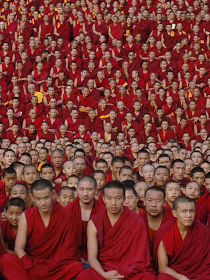- Home
- FPMT Homepage
Foundation for the Preservation of the Mahayana Tradition
The FPMT is an organization devoted to preserving and spreading Mahayana Buddhism worldwide by creating opportunities to listen, reflect, meditate, practice and actualize the unmistaken teachings of the Buddha and based on that experience spreading the Dharma to sentient beings. We provide integrated education through which people’s minds and hearts can be transformed into their highest potential for the benefit of others, inspired by an attitude of universal responsibility and service. We are committed to creating harmonious environments and helping all beings develop their full potential of infinite wisdom and compassion. Our organization is based on the Buddhist tradition of Lama Tsongkhapa of Tibet as taught to us by our founders Lama Thubten Yeshe and Lama Thubten Zopa Rinpoche.
- Willkommen
Die Stiftung zur Erhaltung der Mahayana Tradition (FPMT) ist eine Organisation, die sich weltweit für die Erhaltung und Verbreitung des Mahayana-Buddhismus einsetzt, indem sie Möglichkeiten schafft, den makellosen Lehren des Buddha zuzuhören, über sie zur reflektieren und zu meditieren und auf der Grundlage dieser Erfahrung das Dharma unter den Lebewesen zu verbreiten.
Wir bieten integrierte Schulungswege an, durch denen der Geist und das Herz der Menschen in ihr höchstes Potential verwandelt werden zum Wohl der anderen – inspiriert durch eine Haltung der universellen Verantwortung und dem Wunsch zu dienen. Wir haben uns verpflichtet, harmonische Umgebungen zu schaffen und allen Wesen zu helfen, ihr volles Potenzial unendlicher Weisheit und grenzenlosen Mitgefühls zu verwirklichen.
Unsere Organisation basiert auf der buddhistischen Tradition von Lama Tsongkhapa von Tibet, so wie sie uns von unseren Gründern Lama Thubten Yeshe und Lama Thubten Zopa Rinpoche gelehrt wird.
- Bienvenidos
La Fundación para la preservación de la tradición Mahayana (FPMT) es una organización que se dedica a preservar y difundir el budismo Mahayana en todo el mundo, creando oportunidades para escuchar, reflexionar, meditar, practicar y actualizar las enseñanzas inconfundibles de Buda y en base a esa experiencia difundir el Dharma a los seres.
Proporcionamos una educación integrada a través de la cual las mentes y los corazones de las personas se pueden transformar en su mayor potencial para el beneficio de los demás, inspirados por una actitud de responsabilidad y servicio universales. Estamos comprometidos a crear ambientes armoniosos y ayudar a todos los seres a desarrollar todo su potencial de infinita sabiduría y compasión.
Nuestra organización se basa en la tradición budista de Lama Tsongkhapa del Tíbet como nos lo enseñaron nuestros fundadores Lama Thubten Yeshe y Lama Zopa Rinpoche.
A continuación puede ver una lista de los centros y sus páginas web en su lengua preferida.
- Bienvenue
L’organisation de la FPMT a pour vocation la préservation et la diffusion du bouddhisme du mahayana dans le monde entier. Elle offre l’opportunité d’écouter, de réfléchir, de méditer, de pratiquer et de réaliser les enseignements excellents du Bouddha, pour ensuite transmettre le Dharma à tous les êtres. Nous proposons une formation intégrée grâce à laquelle le cœur et l’esprit de chacun peuvent accomplir leur potentiel le plus élevé pour le bien d’autrui, inspirés par le sens du service et une responsabilité universelle. Nous nous engageons à créer un environnement harmonieux et à aider tous les êtres à épanouir leur potentiel illimité de compassion et de sagesse. Notre organisation s’appuie sur la tradition guéloukpa de Lama Tsongkhapa du Tibet, telle qu’elle a été enseignée par nos fondateurs Lama Thoubtèn Yéshé et Lama Zopa Rinpoché.
Visitez le site de notre Editions Mahayana pour les traductions, conseils et nouvelles du Bureau international en français.
Voici une liste de centres et de leurs sites dans votre langue préférée
- Benvenuto
L’FPMT è un organizzazione il cui scopo è preservare e diffondere il Buddhismo Mahayana nel mondo, creando occasioni di ascolto, riflessione, meditazione e pratica dei perfetti insegnamenti del Buddha, al fine di attualizzare e diffondere il Dharma fra tutti gli esseri senzienti.
Offriamo un’educazione integrata, che può trasformare la mente e i cuori delle persone nel loro massimo potenziale, per il beneficio di tutti gli esseri, ispirati da un’attitudine di responsabilità universale e di servizio.
Il nostro obiettivo è quello di creare contesti armoniosi e aiutare tutti gli esseri a sviluppare in modo completo le proprie potenzialità di infinita saggezza e compassione.
La nostra organizzazione si basa sulla tradizione buddhista di Lama Tsongkhapa del Tibet, così come ci è stata insegnata dai nostri fondatori Lama Thubten Yeshe e Lama Zopa Rinpoche.
Di seguito potete trovare un elenco dei centri e dei loro siti nella lingua da voi prescelta.
- 欢迎 / 歡迎
简体中文
“护持大乘法脉基金会”( 英文简称:FPMT。全名:Foundation for the Preservation of the Mahayana Tradition) 是一个致力于护持和弘扬大乘佛法的国际佛教组织。我们提供听闻,思维,禅修,修行和实证佛陀无误教法的机会,以便让一切众生都能够享受佛法的指引和滋润。
我们全力创造和谐融洽的环境, 为人们提供解行并重的完整佛法教育,以便启发内在的环宇悲心及责任心,并开发内心所蕴藏的巨大潜能 — 无限的智慧与悲心 — 以便利益和服务一切有情。
FPMT的创办人是图腾耶喜喇嘛和喇嘛梭巴仁波切。我们所修习的是由两位上师所教导的,西藏喀巴大师的佛法传承。
繁體中文
護持大乘法脈基金會”( 英文簡稱:FPMT。全名:Found
ation for the Preservation of the Mahayana Tradition ) 是一個致力於護持和弘揚大乘佛法的國際佛教組織。我們提供聽聞, 思維,禪修,修行和實證佛陀無誤教法的機會,以便讓一切眾生都能 夠享受佛法的指引和滋潤。 我們全力創造和諧融洽的環境,
為人們提供解行並重的完整佛法教育,以便啟發內在的環宇悲心及責 任心,並開發內心所蘊藏的巨大潛能 — 無限的智慧與悲心 – – 以便利益和服務一切有情。 FPMT的創辦人是圖騰耶喜喇嘛和喇嘛梭巴仁波切。
我們所修習的是由兩位上師所教導的,西藏喀巴大師的佛法傳承。 察看道场信息:
- FPMT Homepage
- News/Media
-
- Study & Practice
-
-
- About FPMT Education Services
- Latest News
- Programs
- New to Buddhism?
- Buddhist Mind Science: Activating Your Potential
- Heart Advice for Death and Dying
- Discovering Buddhism
- Living in the Path
- Exploring Buddhism
- FPMT Basic Program
- FPMT Masters Program
- FPMT In-Depth Meditation Training
- Maitripa College
- Lotsawa Rinchen Zangpo Translator Program
- Universal Education for Compassion & Wisdom
- Online Learning Center
-
- Prayers & Practice Materials
- Overview of Prayers & Practices
- Full Catalogue of Prayers & Practice Materials
- Explore Popular Topics
- Benefiting Animals
- Chenrezig Resources
- Death & Dying Resources
- Lama Chopa (Guru Puja)
- Lama Zopa Rinpoche: Compendium of Precious Instructions
- Lama Zopa Rinpoche: Life Practice Advice
- Lama Zopa Rinpoche Practice Series
- Lamrim Resources
- Mantras
- Prayer Book Updates
- Purification Practices
- Sutras
- Thought Transformation (Lojong)
- Audio Materials
- Dharma Dates - Tibetan Calendar
- Translation Services
- Publishing Services
- Ways to Offer Support
- Prayers & Practice Materials
-
- Teachings and Advice
- Find Teachings and Advice
- Lama Zopa Rinpoche Advice Page
- Lama Zopa Rinpoche: Compendium of Precious Instructions
- Lama Zopa Rinpoche Video Teachings
- ༧སྐྱབས་རྗེ་བཟོད་པ་རིན་པོ་ཆེ་མཆོག་ནས་སྩལ་བའི་བཀའ་སློབ་བརྙན་འཕྲིན།
- Podcasts
- Lama Yeshe Wisdom Archive
- Buddhism FAQ
- Dharma for Young People
- Resources on Holy Objects
- Teachings and Advice
-
-
*If a menu item has a submenu clicking once will expand the menu clicking twice will open the page.
-
-
- Centers
-
- Teachers
-
- Projects
-
-
-
-
*If a menu item has a submenu clicking once will expand the menu clicking twice will open the page.
-
-
- FPMT
-
- Shop
-
-
-
The Foundation Store is FPMT’s online shop and features a vast selection of Buddhist study and practice materials written or recommended by our lineage gurus. These items include homestudy programs, prayers and practices in PDF or eBook format, materials for children, and other resources to support practitioners.
Items displayed in the shop are made available for Dharma practice and educational purposes, and never for the purpose of profiting from their sale. Please read FPMT Foundation Store Policy Regarding Dharma Items for more information.
-
-
17
His Holiness the Dalai Lama Gives His 34th Kalachakra Initiation
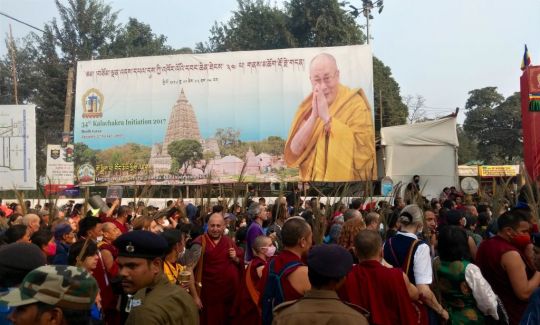
Billboard advertizing the Kalachakra, Bodhgaya, India, December 2016. Photo by Cynthia Karena.
Mandala is pleased to present two reports on the January 2-14, 2017, Kalachakra initiation in Bodhgaya, India, the 34th such initiation His Holiness has granted and the fifth one in Bodhgaya. The first report is by free-lance reporter Cynthia Karena, and the second that follows is by FPMT’s South Asia coordinator, Frances Howland.
Cynthia Karena describes her personal experience of the Kalachakra:
Each morning I looked out over rolling rows of maroon-robed monks and nuns waiting for His Holiness the 14th Dalai Lama to arrive. For ten days, this is how I started my day—joy, anticipation, prayers, mandala offerings, and of course chai (sweet milky tea).
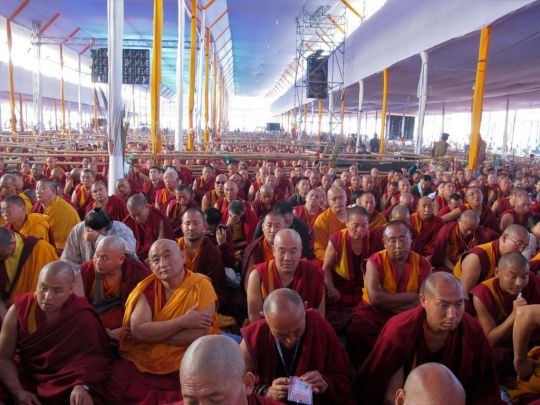
Sangha at Kalachakra, Bodhgaya, India, January 2017. Photo by Jane Seidlitz.
His Holiness launched the event by saying, “In Buddhism, transformation isn’t based on faith. We apply antidotes to negative attitudes.” He emphasized that prayers alone are not enough. Hence, he dived into teachings on emptiness, and pointed out that the Kalachakra initiation is also a tool for transformation, aimed at ripening our minds and empowering us to practice the yoga of the Kalachakra tantra. His teachings were more direct and forthright than I’ve experienced them in the West. He encouraged analysis of everything, not just Buddhist teachings, noting, “We are in a time where we need to check the reality of things, even the Buddhist teachings.”
The crowds were significant—about 200,000 people according to the Central Tibetan Administration. This was fewer than the Kalachakra in Bodhgaya in 2012, but still many people sat outside the teaching grounds in tents and lined the surrounding streets. I heard with sadness that some Tibetans could not attend. It was reported that thousands had to scramble to return to Tibet because authorities had threatened their family members with job loss and other consequences if they did not.
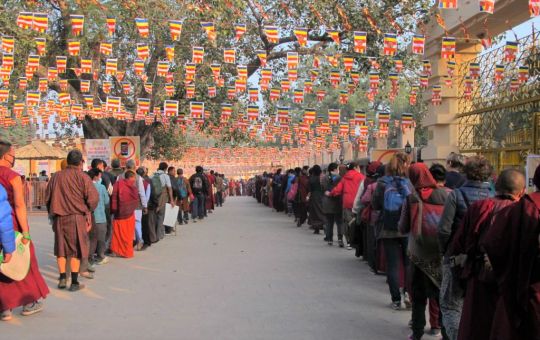
Crowds attending the Kalachakra, Bodhgaya, India, January 2017. Photo by Jane Seidlitz.
In spite of the crowds, I found the event well-organized. Water trucks tried to minimize dust (an almost impossible task with so many people), and organizers were responsive to issues as they arose. After crowds jostled through a bottleneck of buildings the first day, the next day brought better barriers and traffic controls. A police presence ensured security and crowd control. Even viewing the sand mandala at the end was well-organized, with different sections of the audience—Sangha, Tibetans, foreigners—being allocated their own viewing times, making for a sedate rather than frenzied experience as at some past initiations.
And back to the chai. There was always a cup of it to be had during the teachings, and the sight of monks running at top speed through the crowds carrying teapots became a familiar one. While most of us savored our mugs of tea in peace, the occasional person got their head bumped by a metal pot as the tea monks hurtled by. The chai was expertly made in massive pots in a makeshift kitchen nearby; under the circumstances, I had to admire its quality and quantity!
The experience offered me a huge dose of inspiration to apply antidotes to negative attitudes. My challenge will be to keep going once home—away from the tremendous spiritual inspiration of His Holiness.
Cynthia Karena is a member of Tara Institute in Melbourne, Australia, who regularly travels to India. She is also a journalist and researcher, and has degrees in science and education.
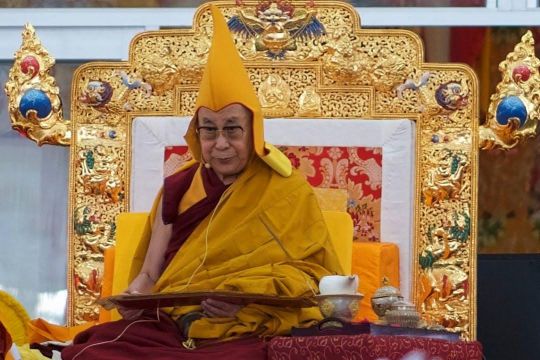
His Holiness the Dalai Lama, Bodhgaya, India, January 2017. Photo by Bill Kane.
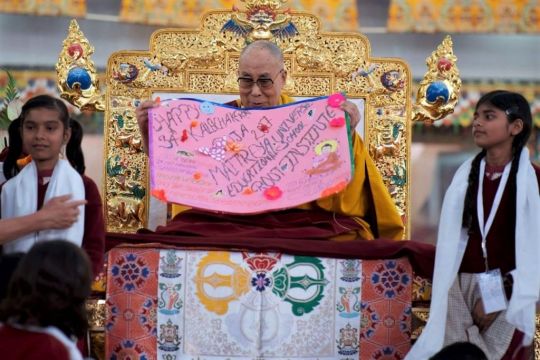
His Holiness the Dalai Lama holding up a placard offering good wishes made by student of FPMT’s Maitreya School. Bodhgaya, India, January 2017. Photo by Bill Kane.
Frances Howland describes the details of the Kalachakra and the role of FPMT:
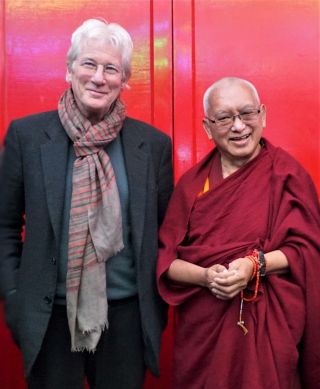
Lama Zopa Rinpoche and Richard Gere attending the Kalachakra, Bodhgaya, India, January 2017
Students from FPMT centers around the globe assembled in Bodhgaya in January for the Kalachakra. FPMT’s Root Institute for Wisdom Culture, set amidst beautiful grounds overflowing with statues and stupas, was filled with guests including Lama Zopa Rinpoche; Tenzin Ösel Hita; Yangsi Rinpoche; Cherok Lama; Tenzin Phuntsok Rinpoche; Tenzin Rigsel, the three-year-old reincarnation of the late Khen Rinpoche Lama Lhundrup; and other lamas and geshes, as well as many FPMT Sangha. Even actor Richard Gere was among the guests.
His Holiness Karmapa, head of the Karma Kagyü school; His Holiness Sakya Trizin, head of the Khon Sakya lineage; and the newly appointed 103rd Ganden Tripa, His Eminence Sharpa Chöje Jetsun Lobsang Tenzin, the head of the Gelug lineage, all sat alongside His Holiness the Dalai Lama during the initiation.
More than 220,000 people in total gathered to participate in the ceremony. It was translated into nineteen languages simultaneously, and broadcast on various FM channels to those present. His Holiness was visible to the whole teaching ground area, and tech-savvy monks captured and broadcast the event live on sixteen mammoth LCD screens and eighteen televisions.
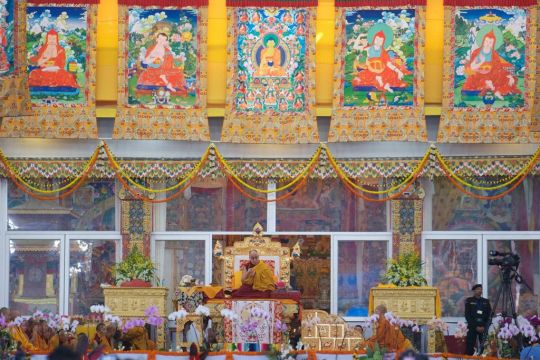
His Holiness the Dalai Lama, Bodhgaya, India, January 2017. Photo by Bill Kane.
The Tibetan diaspora arrived in force for the event, while Buddhists from across greater Asia appeared in vibrant ethnic costumes. Over 40,000 people came from the Himalayan regions, including Nepal, Ladakh, Bhutan, and other areas. In recent years, the event has also seen the participation of many Buddhists from inside China; this time there were approximately 2,200 participants from Hong Kong and the Chinese mainland, alongside 8,500 Westerners. Ninety-two countries in total were represented. Participants sat on the ground under the blue and white ceiling of a huge tent, with special areas allotted to each group.
Twice daily, monks and other volunteers delivered refreshments to the appreciative crowds: salty butter tea with rounds of Tibetan bread in the morning and sweet tea in the afternoon, meaning more than 200,000 pieces of bread were made each day along with enough tea to fill seven metal pots each holding 3,000 liters (800 gallons). Sangyal Gyal, who has made the bread for three previous Kalachakras, was in charge of the massive operation, overseeing 300 staff. All the ingredients were paid for by donations.
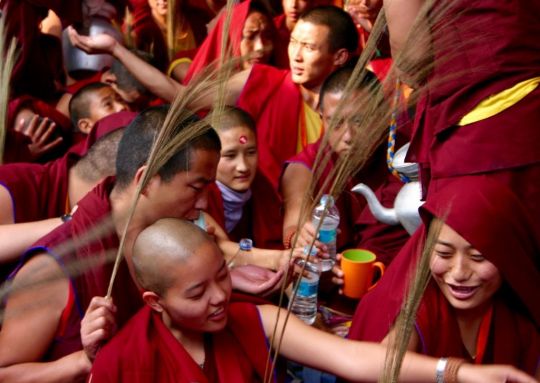
Tea, water, and kusha grass for the initiation, Bodhgaya, India, January 2017. Photo by Cynthia Karena.
The program started on January 2 with four days of teachings on Shantideva’s A Guide to the Bodhisattva’s Way of Life and Kamalashila’s The Middling States of Meditation. Then came the Kalachakra itself. Kalachakra, or “Wheel of Time,” is a tantric practice that, although advanced and esoteric, has a tradition of being offered to large public audiences. The practice revolves around the concept of time (Skt. kala) and cycles (Skt. chakra), from the cycles of the planets to the cycles of human breathing. It teaches how to work with the most subtle energies in the body on the path to enlightenment while developing bodhichitta, the aspiration to attain enlightenment for the sake of all sentient beings.

Sand mandala, Bodhgaya, India, January 2017. Photo by Cynthia Karena
The main Kalachakra deity resides in the center of a three-dimensional mandala palace along with many other deities. The palace is represented by a six-colored mandala of sand particles made on site by specially trained monks and dedicated to both individual and world peace; everyone was able to view the mandala. His Holiness explained, “[The Kalachakra initiation] is a way of planting a seed. The seed will have a karmic effect. And one doesn’t need to be present at the Kalachakra ceremony in order to receive its benefits.”
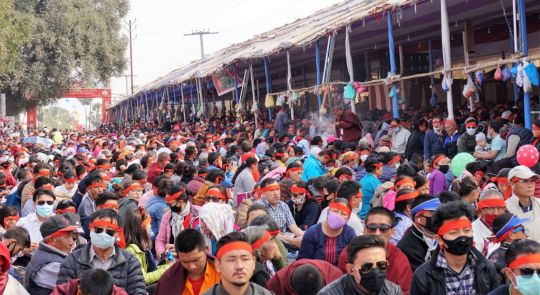
Crowds preparing for the initiation, Bodhgaya, India, January 2017
The event was completed on January 14 with the conferring of an Avalokiteshvara empowerment (Tib. jenang) known as “Chenrezig Who Saves from the Lower Realms,” followed by a long-life ceremony offered to His Holiness. His Holiness summed up for those who had gathered, saying that they must not go empty-handed back to their lives after the teaching. Rather, they must go home with kinder hearts, as people who, if they cannot do good, at least should do no harm. He went on to say that since we all have the seeds of compassion in us, we must nurture them by using our intelligence to identify the advantages of having compassion and disadvantages of not having it.
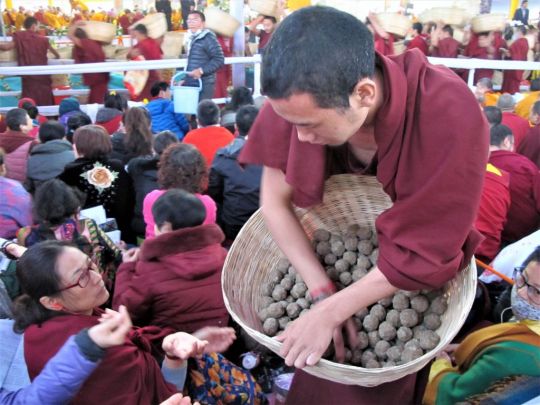
Monks hand out long life pills made of tsampa to the crowd, Bodhgaya, India, January 2017. Photo by Jane Seidlitz.
There was one particularly exciting moment for FPMT. It has long been the tradition at the beginning of the teachings for different groups of people to sit before His Holiness and recite the Heart Sutra. Root Institute’s own Maitreya School, a free school benefiting impoverished children from Bodhgaya and neighboring villages, was given the opportunity to do this at the 2017 Kalachakra.
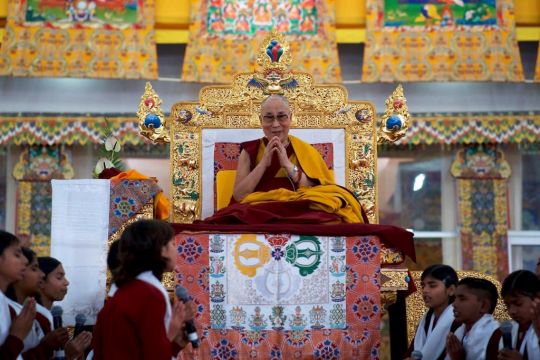
Maitreya School students recite the Heart Sutra in Sanskrit to His Holiness, Bodhgaya, India, January 2017. Photo by Bill Kane.
Ven. Tenzin Paldron, director of Root Institute, explained: “Dee Chandrashekhar, FPMT India’s national coordinator, had developed a tune for the Heart Sutra in Sanskrit and a couple of years ago Lama Zopa Rinpoche asked her to come and teach it to the Maitreya School children. She came last summer, and the children learned it. With their teacher they reviewed it on a regular basis, to the point where they felt confident. They were ready. Twelve girls and one boy sat in front of His Holiness and the whole audience and recited the Heart Sutra. They also offered a handmade placard with wishes for a happy 34th Kalachakra puja. It was historic; I don’t think children have recited the Heart Sutra in Sanskrit for His Holiness before. And they are very devoted when they recite—they do it with their full heart. His Holiness was deeply moved; he called it ‘wonderful’ and ‘inspiring.’ And he offered one hundred thousand rupees (US$1,500) to be used to take all 190 of the Maitreya School children on a picnic. The children were so happy!”
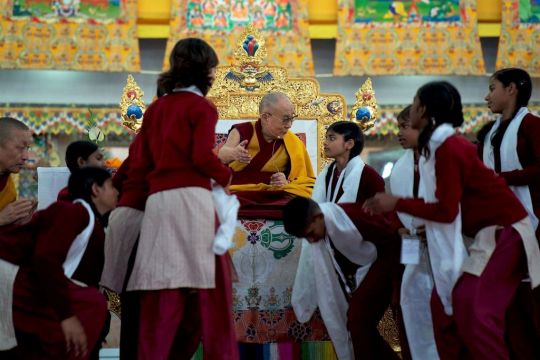
His Holiness talks with students from Maitreya School after their recitation, Bodhgaya, India, January 2017. Photo by Bill Kane.
Mandala asked several participants about their experiences. Cherok Lama, now in his mid-20s, lives at Sera Je’s Kopan House and is currently in his second year of Madhyamaka studies. Rinpoche described his experience of the Kalachakra: “I traveled here by train from Bangalore with around sixty other Kopan monks from Sera Je and the tantric college. It took us eighteen hours to reach Varanasi and then we were delayed for a day by fog. At the teaching site the geshes were seated down with the monks and the rinpoches up on the stage with the dignitaries. I was in the Sera Je lama group. There were seven of us sitting together including three from Kopan. On the first day, the two staying closest to the teaching grounds got up at 4 a.m. to come and save us places on the stage so we could sit together.” He added, “The last time I was here I was younger and less interested in the teachings. I was more interested in being in the crowd and mingling. This Kalachakra is my fourth or fifth, and because I have finished my Prajñaparamita studies I could better understand the teachings His Holiness gave. It has been much, much more meaningful this time.”
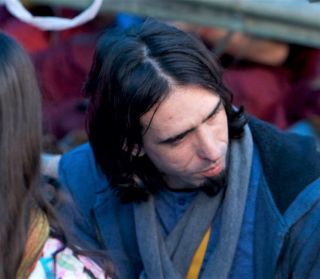
Tenzin Ösel Hita at the initiation, Bodhgaya, India, January 2017. Photo by Bill Kane.
Ven. Paldron also told Mandala how Root Institute was involved in the Kalachakra. “Getting ready for the Kalachakra has been an intense time for us. We are packed with about 150 guests and many more staying in tents in our nearby Stupa Garden of Compassion. Even getting this place ready felt like a purification in preparation for the Kalachakra. And then it was so special to see all the flowers blossoming and to have FPMT Sangha and lay people from all over the world! We formed a Root Institute Kalachakra organizing team of around twelve very competent and dedicated people who came together to prepare a newsletter, print fliers, figure out the food, and deal with registration and accommodation. Overall, people seemed very pleased. I feel very, very grateful.”
Gabriel Forrer from the Netherlands was the director of Root Institute from 1990 to 1995. Lama Zopa Rinpoche asked him to return to Bodhgaya to help get everything ready for this Kalachakra. He reported that “it was a lot of work for me and the twenty-two Indian staff who were hired for this purpose. All of us working here were too busy to attend any of the teachings but we were able to watch it in the gompa via live streaming. We felt very fortunate!”
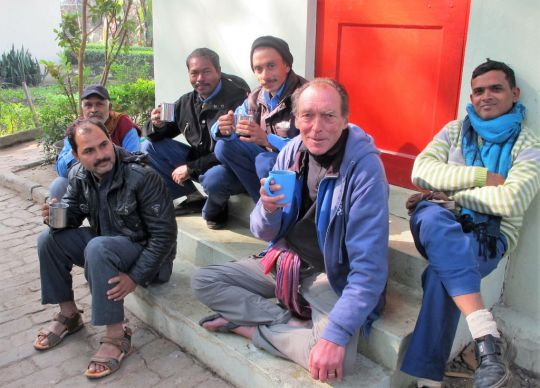
Gabriel Forrer with some of the workers at Root Institute, Bodhgaya, India, January 2017. Photo by Jane Seidlitz.
Rafael Ferrer from Spain is the FPMT’s European regional coordinator. He said, “Coming to Bodhgaya, especially for a Kalachakra with His Holiness, is an opportunity to know yourself better, to connect to yourself. We are very lucky to have Root Institute as our center where we can stay. Seeing Lama Zopa Rinpoche and all the other lamas coming and going gives a sense of family, and you meet so many Dharma friends. I felt really lucky to be able to visit the Mahabodhi Stupa and to practice and meditate there. It is probably the best place in the world to do that. I encourage everyone to come here!”
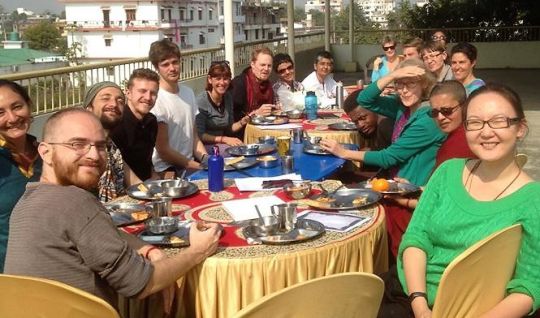
Some of Root Institute’s Kalachakra volunteers, Bodhgaya, India, January 2017. Photo from Root Institute via Facebook.
FPMT’s national coordinator for the Netherlands and former European regional coordinator Annelies van der Heijden, from Amsterdam, was at her first Kalachakra. “I do not usually like crowds, but somehow this one seemed quite relaxed. I expected more panic, more busyness, more tension. It was very inspiring even apart from the teachings, mainly because of the organization but also because of what His Holiness is trying to establish in the world among different religions. The first day, there was an interfaith event with so many religious traditions represented. I think this is such a big message for the whole world. It is not that it is new, but I think on this scale and at this time it is so relevant.”
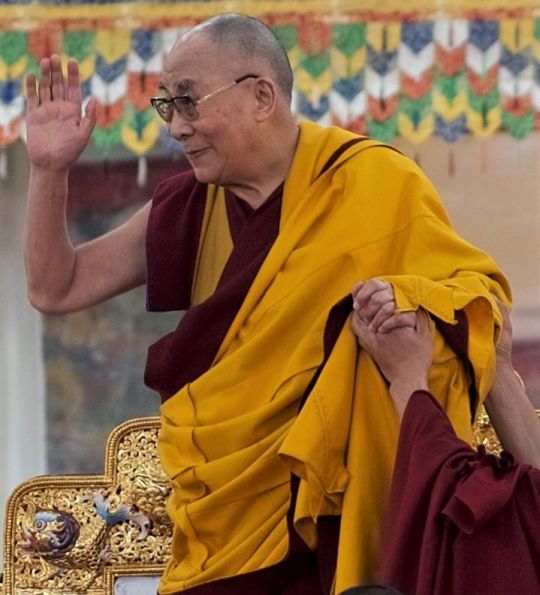
Bodhgaya, India, January 2017. Photo by Bill Kane.
On the final day of the ceremony, in front of the crowds and in the presence of Bihar’s chief minister Nitish Kumar and Tibetan prime minister Dr. Lobsang Sangay, His Holiness called the 34th Kalachakra in Bodhgaya “a tremendous success.” Prime Minister Lobsang Sangay thanked His Holiness, praising him as “the greatest Nalanda master of this century.” His Holiness indicated that he would offer more Kalachakra initiations in future, given that he expects to live past the age of 100. What good fortune for everyone!
Frances Howland lives in Nepal. A midwife, she works in the field of health in South Asia and Tibet. Frances has worked for the FPMT since 1984 and is currently the FPMT South Asia regional coordinator. She has a Master’s degree in public health.
Mandala is offered as a benefit to supporters of the Friends of FPMT program, which provides funding for the educational, charitable, and online work of FPMT.
- Home
- News/Media
- Study & Practice
- About FPMT Education Services
- Latest News
- Programs
- New to Buddhism?
- Buddhist Mind Science: Activating Your Potential
- Heart Advice for Death and Dying
- Discovering Buddhism
- Living in the Path
- Exploring Buddhism
- FPMT Basic Program
- FPMT Masters Program
- FPMT In-Depth Meditation Training
- Maitripa College
- Lotsawa Rinchen Zangpo Translator Program
- Universal Education for Compassion & Wisdom
- Online Learning Center
- Prayers & Practice Materials
- Overview of Prayers & Practices
- Full Catalogue of Prayers & Practice Materials
- Explore Popular Topics
- Benefiting Animals
- Chenrezig Resources
- Death & Dying Resources
- Lama Chopa (Guru Puja)
- Lama Zopa Rinpoche: Compendium of Precious Instructions
- Lama Zopa Rinpoche: Life Practice Advice
- Lama Zopa Rinpoche Practice Series
- Lamrim Resources
- Mantras
- Prayer Book Updates
- Purification Practices
- Sutras
- Thought Transformation (Lojong)
- Audio Materials
- Dharma Dates – Tibetan Calendar
- Translation Services
- Publishing Services
- Teachings and Advice
- Find Teachings and Advice
- Lama Zopa Rinpoche Advice Page
- Lama Zopa Rinpoche: Compendium of Precious Instructions
- Lama Zopa Rinpoche Video Teachings
- ༧སྐྱབས་རྗེ་བཟོད་པ་རིན་པོ་ཆེ་མཆོག་ནས་སྩལ་བའི་བཀའ་སློབ་བརྙན་འཕྲིན།
- Podcasts
- Lama Yeshe Wisdom Archive
- Buddhism FAQ
- Dharma for Young People
- Resources on Holy Objects
- Ways to Offer Support
- Centers
- Affiliates Area
- Teachers
- Projects
- Charitable Projects
- Make a Donation
- Applying for Grants
- News about Projects
- Other Projects within FPMT
- Support International Office
- Projects Photo Galleries
- Give Where Most Needed
- FPMT
- Shop
Translate*
*powered by Google TranslateTranslation of pages on fpmt.org is performed by Google Translate, a third party service which FPMT has no control over. The service provides automated computer translations that are only an approximation of the websites' original content. The translations should not be considered exact and only used as a rough guide.If we want to understand how we are ordinarily misled by our false projections and how we break free from their influence, it is helpful to think of the analogy of our dream experiences. When we wake up in the morning, where are all the people we were just dreaming about? Where did they come from? And where did they go? Are they real or not?







